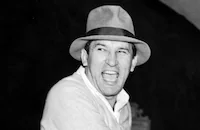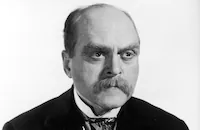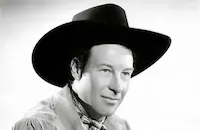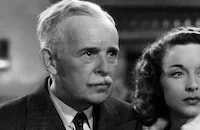The Secret Bride

Brief Synopsis
Cast & Crew
William Dieterle
Barbara Stanwyck
Warren William
Glenda Farrell
Grant Mitchell
Arthur Byron
Film Details
Technical Specs

Synopsis
District Attorney Robert Sheldon is secretly married to Governor Vincent's daughter Ruth. When Dave Bredeen, Sheldon's assistant, informs him that the governor has been accused of taking a bribe and Sheldon is put in charge of the investigation, Ruth feels they should keep their marriage a secret, so that no one will think he is a prejudiced investigator. The charges against Vincent stem from money that John Holdstock's secretary, Willis Martin, deposited in Vincent's personal bank account. Everyone believes that the money was a reward for Vincent's pardon of Holdstock, and Holdstock commits suicide before he can confirm or deny this. Every piece of evidence that Sherman uncovers seems to point to Vincent's guilt, but Ruth continues to believe in her father's innocence. As Ruth waits for Sherman late one night in his apartment, she witnesses Bredeen's murder. From her vantage point, she can see that Hazel Normandie, Sherman's secretary, definitely did not do the shooting, but she refuses to testify because she would have to reveal her marriage in order to explain her presence in Sherman's apartment. Determined to clear her father's name before Hazel's trial is over, Ruth tracks down Martin. He admits that Holdstock was murdered, but before she can force him to tell Sheldon, he escapes. Sheldon sends the police after Martin and Ruth testifies in time to save Hazel from murder charges. As news of Sheldon's and Ruth's marriage makes all the newspapers, Jim Lansdale, Vincent's financier, advises him to resign his office. The police find Martin, who reveals that, goaded by Bredeen, he killed Holdstock in anger. Bredeen then forced him to deposit the money. Martin also reveals that he later killed Bredeen, but the man behind the whole set-up is Lansdale. Charges against Vincent are dropped and in disgrace, Lansdale kills himself.

Director

William Dieterle
Cast

Barbara Stanwyck

Warren William

Glenda Farrell

Grant Mitchell

Arthur Byron

Henry O'neill

Douglas Dumbrille
Arthur Aylesworth
Willard Robertson

William Davidson

Russell Hicks

Vince Barnett
Frank Darien
John Larkin

Emmett Vogan
Frank Dawson

Gordon Elliott
Bill Ray
James P. Burtis
Spencer Charters

James Burke
Wade Boteler
Cliff Saum
Thomas E. Jackson
Charles C. Wilson
Katherine Clare Ward
Florence Fair

Walter Walker
Rosalie Roy
Purnell Pratt
Wallis Clark

Wilfred Lucas
Eddy Chandler
Samuel T. Godfrey
Milton Kibbee
Frederick Burton
Samuel E. Hines
Monte Vandergrift
Davison Clark

Howard Hickman
Selmer Jackson
Niles Welch

Joseph Crehan
Mary Russell
Nick Copeland
Crew

Film Details
Technical Specs

Articles
The Secret Bride
Under the working title Concealment (the name of the play it was based on), the script had plenty of melodramatic details in the form of murder, suicide, and false accusations, and the talented Dieterle works valiantly to give the picture visual and rhythmic interest by way of a restless, probing camera, fast editing, and some striking low angles. Nevertheless, he and his star were less than enthusiastic about the project. As he said later: "The work on the film...was not very pleasant. The script was bad. I could not refuse it for contractual reasons. Why Miss Stanwyck did not reject the script, as Bette Davis would have done, I can only guess. She was not happy at Warners and wanted to get out of her contract as quickly as possible. Of all the films I directed, Concealment [sic] is the picture I don't like to think about any more."
Stanwyck made one more picture under her Warners contract, The Woman in Red (1935), then happily left the studio for bigger and better things. She freelanced quite successfully for every one of the other major studios and didn't return to Warner Brothers until Meet John Doe (1941), largely for the chance to work again with one her favorite directors, Frank Capra.
With this film, Stanwyck's co-star, Warren William, began his descent from his success in pre-Code pictures, usually as a conscienceless rogue, often playing cold-hearted, shady lawyers and businessmen. Seen today, with his patrician bearing, sharp profile, and somewhat oily demeanor, William strikes us as a kind of bargain-basement John Barrymore, but his rich, mellifluous voice made him a natural for the early days of talkies. After prominent roles in the classic musical Gold Diggers of 1933 (1933), Frank Capra's Lady for a Day (1933), and the original Imitation of Life (1934), William slid into a series of B or nearly B pictures. In real life, we was a rather shy and unostentatious man and an inventor with multiple patents to his credit, including his design of one of the first recreational vehicles, which he reportedly developed so he could continue to sleep comfortably while being driven to the studio for work. He made his last screen appearance in 1947 and died the following year of multiple myeloma at only 53 years old.
Although she gives her usual best, Stanwyck has to be content with playing the society woman whose subdued nature only gets a workout in her efforts to defend her father ("playing a man's game with the heart of a woman" the trailer's tagline said). The role of the sharp-tongued secretary--the kind of image Stanwyck projected in her earlier Warners pictures--goes to Glenda Farrell, the perpetual second-stringer who made a name for herself in hard-boiled supporting roles and as the fast-talking (reportedly 390 words per minute) reporter Torchy Blaine in a series of films based on the character.
Another participant in this production who would rise to far greater heights is cinematographer Ernest Haller, who started with First National Pictures in 1926 and stayed on when that studio became absorbed by Warner Brothers in 1930. Although at this point Haller's work hadn't achieved much distinction, he would soon be highly sought after following his cinematography of Captain Blood (1935) and the Bette Davis costume drama Jezebel (1938). His Academy Award nomination for that epic of the Old South might have been at least in part responsible for getting him the plum assignment on Gone With the Wind (1939), which brought him an Oscar®. He was nominated five more times, including Mildred Pierce (1945) and What Ever Happened to Baby Jane? (1962), one of 13 pictures in which he photographed Bette Davis. This was his third and last film with Stanwyck.
Dieterle went on to a long career distinguished by his work on several of the major historical biographies produced at Warners and starring Paul Muni or Edward G. Robinson. His most notable work, a pet project produced by his own company, was the period fantasy The Devil and Daniel Webster (1941).
Director: William Dieterle
Screenplay: Tom Buckingham, F. Hugh Herbert, and Mary McCall Jr., based on the play Concealment by Leonard Ide
Cinematography: Ernest Haller
Editing: Owen Marks
Art Direction: Anton Grot
Cast: Barbara Stanwyck (Ruth Vincent), Warren William (Robert Sheldon), Glenda Farrell (Hazel Normandie), Grant Mitchell (Willis Martin), Arthur Byron (Governor Vincent).
BW-64m.
by Rob Nixon

The Secret Bride
Quotes
Trivia
Notes
The film's working titles were Concealment and His Secret Bride.















